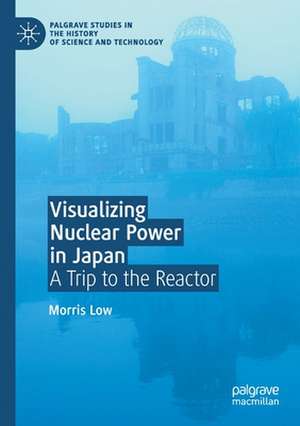Visualizing Nuclear Power in Japan: A Trip to the Reactor: Palgrave Studies in the History of Science and Technology
Autor Morris Lowen Limba Engleză Paperback – 29 mai 2021
| Toate formatele și edițiile | Preț | Express |
|---|---|---|
| Paperback (1) | 638.43 lei 43-57 zile | |
| Springer International Publishing – 29 mai 2021 | 638.43 lei 43-57 zile | |
| Hardback (1) | 642.68 lei 43-57 zile | |
| Springer International Publishing – 29 mai 2020 | 642.68 lei 43-57 zile |
Din seria Palgrave Studies in the History of Science and Technology
-
 Preț: 352.16 lei
Preț: 352.16 lei -
 Preț: 223.88 lei
Preț: 223.88 lei -
 Preț: 458.01 lei
Preț: 458.01 lei - 18%
 Preț: 783.81 lei
Preț: 783.81 lei - 15%
 Preț: 645.93 lei
Preț: 645.93 lei - 18%
 Preț: 734.09 lei
Preț: 734.09 lei - 15%
 Preț: 698.94 lei
Preț: 698.94 lei - 15%
 Preț: 640.37 lei
Preț: 640.37 lei - 15%
 Preț: 695.01 lei
Preț: 695.01 lei -
 Preț: 385.25 lei
Preț: 385.25 lei -
 Preț: 323.28 lei
Preț: 323.28 lei -
 Preț: 332.33 lei
Preț: 332.33 lei -
 Preț: 389.11 lei
Preț: 389.11 lei - 18%
 Preț: 786.98 lei
Preț: 786.98 lei -
 Preț: 383.93 lei
Preț: 383.93 lei - 18%
 Preț: 723.24 lei
Preț: 723.24 lei - 18%
 Preț: 948.16 lei
Preț: 948.16 lei - 18%
 Preț: 795.83 lei
Preț: 795.83 lei - 18%
 Preț: 732.52 lei
Preț: 732.52 lei -
 Preț: 383.93 lei
Preț: 383.93 lei -
 Preț: 384.86 lei
Preț: 384.86 lei - 18%
 Preț: 731.91 lei
Preț: 731.91 lei - 18%
 Preț: 727.18 lei
Preț: 727.18 lei -
 Preț: 391.02 lei
Preț: 391.02 lei - 18%
 Preț: 729.68 lei
Preț: 729.68 lei -
 Preț: 398.35 lei
Preț: 398.35 lei - 15%
 Preț: 645.79 lei
Preț: 645.79 lei -
 Preț: 420.97 lei
Preț: 420.97 lei - 15%
 Preț: 582.80 lei
Preț: 582.80 lei -
 Preț: 213.58 lei
Preț: 213.58 lei - 18%
 Preț: 785.11 lei
Preț: 785.11 lei -
 Preț: 385.84 lei
Preț: 385.84 lei -
 Preț: 388.52 lei
Preț: 388.52 lei -
 Preț: 417.68 lei
Preț: 417.68 lei -
 Preț: 385.84 lei
Preț: 385.84 lei
Preț: 638.43 lei
Preț vechi: 751.10 lei
-15% Nou
Puncte Express: 958
Preț estimativ în valută:
122.19€ • 125.93$ • 103.16£
122.19€ • 125.93$ • 103.16£
Carte tipărită la comandă
Livrare economică 03-17 martie
Preluare comenzi: 021 569.72.76
Specificații
ISBN-13: 9783030472009
ISBN-10: 3030472000
Pagini: 260
Ilustrații: XIII, 260 p.
Dimensiuni: 148 x 210 mm
Greutate: 0.36 kg
Ediția:1st ed. 2020
Editura: Springer International Publishing
Colecția Palgrave Macmillan
Seria Palgrave Studies in the History of Science and Technology
Locul publicării:Cham, Switzerland
ISBN-10: 3030472000
Pagini: 260
Ilustrații: XIII, 260 p.
Dimensiuni: 148 x 210 mm
Greutate: 0.36 kg
Ediția:1st ed. 2020
Editura: Springer International Publishing
Colecția Palgrave Macmillan
Seria Palgrave Studies in the History of Science and Technology
Locul publicării:Cham, Switzerland
Cuprins
1. Introduction: Visualizing Nuclear Power in Japan.- 2. Before and After Hiroshima.- 3. Picturing Hiroshima.- 4. The Beginnings of Atoms for Peace in Japan.- 5. Nuclear Testing in the Pacific: The Lucky Dragon Incident and the Family of Man.- 6. Living in Fear: Nuclear Films.- 7. Making Atomic Dreams Real: 1956-1958.- 8. Seeing Reactors at Tōkai-mura, Trade Fairs, Department Stores and in Films: 1957-1971.- 9. Shaping the National Narrative: From Hiroshima to Fukushima and Beyond.- 10. Conclusion.
Recenzii
“This book is an important contribution to the Anglophone literature. … Low’s monograph is informative, well researched, and a good resource for learning about Japan’s rejection of nuclear weapons while still embracing nuclear energy.” (Yuki Miyamoto, Technology and Culture, Vol. 63 (3), July, 2022)
“Visualizing Nuclear Power in Japan offers a compelling narrative that shows the rich potential of a visualapproach in the history of technology. … Low notes that the story is still being written—an opportunity, then, for others to build on his fascinating work.” (Ruselle Meade, Isis, Vol. 113 (1), March, 2022)
“The strength of the book is definitively its rich historical materialsand its evocative writing. For a work of history, the book reads almost like an ethnography. … the book is too specialized to be of interest to undergraduate students, but it will definitely become a staple for scholars studying the aftermath of the 2011 Fukushima nuclear disaster. In that regard, the book contributes to the growing literature on nuclear propaganda, a subject that remains important and controversial.” (Maxime Polleri, Metascience, Vol. 30 (1), 2021)
“Visualizing Nuclear Power in Japan offers a compelling narrative that shows the rich potential of a visualapproach in the history of technology. … Low notes that the story is still being written—an opportunity, then, for others to build on his fascinating work.” (Ruselle Meade, Isis, Vol. 113 (1), March, 2022)
“The strength of the book is definitively its rich historical materialsand its evocative writing. For a work of history, the book reads almost like an ethnography. … the book is too specialized to be of interest to undergraduate students, but it will definitely become a staple for scholars studying the aftermath of the 2011 Fukushima nuclear disaster. In that regard, the book contributes to the growing literature on nuclear propaganda, a subject that remains important and controversial.” (Maxime Polleri, Metascience, Vol. 30 (1), 2021)
Notă biografică
Dr. Morris Low is Associate Professor of Japanese History at the University of Queensland, Brisbane, Australia.
Caracteristici
Examines the forces that shaped Japanese images of nuclear power from the Pacific War to the Fukushima nuclear disaster and beyond Highlights the impact of visual media in promoting nuclear power in Japan, including discussion on the “atoms for peace” program and US-Japan relations Appeals to scholars of Japanese history, history of science and technology, art history, film studies, and politics
